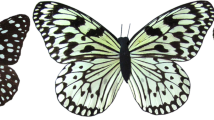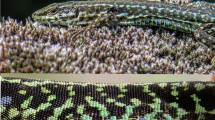Abstract
Visual and olfactory mediated cues play a major role in mate selection in different groups of insects. This study aimed to observe if there is any role of mate color (under different wavelengths) and/or cuticular hydrocarbons in mate selection of Aulacophora foveicollis. In this study, visual cues and olfactory cues showed a vital role for male A. foveicollis to find mates. Males preferred (81%) orange (similar body colour) coloured glass model than white (52%) and black (49%) under the visible spectrum; whereas under the UV spectrum white coloured model was more preferred (77%) than orange (60%) and black (48%) coloured. In contrast, unresponsive males were very high though white coloured model was still preferred (36.67%) than orange (24.44%) or black (22.22%) coloured under IR spectrum. It was also observed that body surface waxes can play alone an olfactory cue for male mate selection (attraction was 67%) from short distance. Under the visual spectrum, when both visual and olfactory cues were presented, attraction of males toward all orange (93%), white (74%), and black (71%) coloured glass bead model increased. Even under UV and IR spectra attraction increased when body surface extract of female was applied on the glass models though the preference was more towards white coloured model than orange as previous. Male A. foveicollis showed less preference towards black colour. These works provide evidence that both visuals and olfactory cues can act separately as well as synergistically to find mates for male insects. These findings will be helpful for sustainable pest management program.






Similar content being viewed by others
References
Barbour JD, Lacey ES, Hanks LM (2007) Cuticular hydrocarbons mediate mate recognition in a species of longhorned beetle (Coleoptera: Cerambycidae) of the primitive subfamily Prioninae. Ann Entomol Soc Am 100:333–338
Candolin U (2003) The use of multiple cues in mate choice. Biol Rev 78:575–595
Ferveur JF (2005) Cuticular hydrocarbons: their evolution and roles in Drosophila pheromonal communication. Behav Genet 35:279–295
Fukaya M, Akino T, Yasuda T, Wakamura S, Satoda S, Senda S (2000) Hydrocarbon components in contact sex pheromone of the white-spotted longicorn beetle, Anoplophora malasiaca (Thomson) (Coleoptera: Cerambycidae) and pheromonal activity of synthetic hydrocarbons. Entomol Sci 3:211–218
Fukaya M, Akino T, Yasuda T, Yasui H, Wakamura S (2004) Visual and olfactory cues for mate orientation behaviour in male white-spotted longicorn beetle, Anoplophora malasiaca. Entomol Exp Appl 111:111–115
Ginzel MD, Hanks LM (2003) Contact pheromones as mate recognition cues of four species of longhorned beetles (Coleoptera: Cerambycidae). J Insect Behav 16:181–187
Greenspan RJ, Ferveur JF (2000) Courtship in Drosophila. Annu Rev Genet 34:205–232
Hausmann C, Samietz J, Dorn S (2004) Visual orientation of overwintered Anthonomus pomorum (Coleoptera: Curculionidae). Environ Entomol 33:1410–1415
Holdcraft R, Rodriguez-Saona C, Stelinski LL (2016) Pheromone autodetection: evidence and implications. Insects 7:17
Howard RW, Blomquist GJ (2005) Ecological, behavioral, and biochemical aspects of insect hydrocarbons. Annu Rev Entomol 50:371–393
Karmakar A, Barik A (2016) Solena amplexicaulis (Cucurbitaceae) flower surface wax influencing attraction of a generalist insect herbivore, Aulacophora foveicollis (Coleoptera: Chrysomelidae). Int J Trop Insect Sc 36:70–81
Karmakar A, Malik U, Barik A (2016) Effects of leaf epicuticular wax compounds from Solena amplexicaulis (lam.) Gandhi on olfactory responses of a generalist insect herbivore. Allelopathy J 37:253–272
Karmakar A, Mitra S, Barik A (2017) Systemically released volatiles from Solena amplexicaulis plant leaves with color cues influencing attraction of a generalist insect herbivore. Int J Pest Manage 64:210–220
Khan MMH, Alam MZ, Rahaman MM (2011) Host preference of red pumpkin beetle in a choice test under net case condition. Bangladesh J Zool 39:231–234
Koschier EH, Kogel WJD, Visser J (2000) Assessing the attractiveness of volatile plant compounds to western flower thrips Frankliniella occidentalis. J Chem Ecol 26:2643–2655
Koshitaka H, Kinoshita M, Vorobyev M, Arikawa K (2008) Tetrachromacy in a butterfly that has eight varieties of spectral receptors. Proc R Soc Lond B 275:947–954
Kühnle A, Müller C (2011) Relevance of visual and olfactory cues for host location in the mustard leaf beetle Phaedon cochleariae. hysiol. Entomol 36:68–76
Kumar SK, Nadarajan L (2008) Evidence of female–produced sex pheromone in red pumpkin beetle, Aulacophora foveicollis Lucas (Coleoptera: Chrysomelidae). Curr Sci 94:1369–1371
Mukherjee A, Sarkar N, Barik A (2015) Momordica cochinchinensis (Cucurbitaceae) leaf volatiles: semiochemicals for host location by the insect pest, Aulacophora foveicollis (Coleoptera: Chrysomelidae). Chemoecology 25:93–104
Mukherjee A, Karmakar A, Barik A (2017) Bionomics of Aulacophora foveicollis (Coleoptera: Chrysomelidae) by feeding on Momordica cochinchinensis. Proc Zool Soc 70:81–87
Lu W, Wang Q, Tian M Y, He X Z, Zeng X L , Zhong Y X (2007) Mate location and recognition in Glenea cantor (Fabr.) (Coleoptera: Cerambycidae: Lamiinae): Roles of host plant health, female sex pheromone, and vision. Environ Entomol 36:864–870
Otálora-Luna F, Dickens JC (2011) Spectral preference and temporal modulation of photic orientation by Colorado potato beetles on a servosphere. Entomol Exp Appl 138:93–103
Peterson MA, Dobler S, Larson EL, Juarez D, Schlarbaum T, Monsen KJ, Francke W (2007) Profiles of cuticular hydrocarbons mediate male mate choice and sexual isolation between hybridizing Chrysochus (Coleoptera: Chrysomelidae). Chemoecology 17:87–96
Piñero JC (2018) A comparative assessment of the response of two species of cucumber beetles (Coleoptera: Chrysomelidae) to visual and olfactory cues and prospects for mass trapping. J Econ 111:1439–1445
Rahaman MA, Prodhan MDH (2007) Effects of net barrier and synthetic pesticides on red pumpkin beetle and yield of cucumber. Int J Sustain Crop Prod 2:30–34
Reisenman CE, Lorenzo-FigueirasA NL, Giurfa M, Lazzari CR (2000) Interaction of visual and olfactory cues in the aggregation behaviour of the haematophagous bug Triato mainfestans. J Comp Physiol 186:961–968
Rodstein J, Mc Elfresh JS, Barbour JD, Ray AM, Hanks LM, Millar JG (2009) Identification and synthesis of a female-produced sex pheromone for the cerambycid beetle Prionus californicus. J Chem Ecol 35:590–600
Roelofs WL, Rooney AP (2003) Molecular genetics and evolution of pheromone biosynthesis in Lepidoptera. Proc Natl Acad Sci U S A 100:9179–9184
Roy N, Laskar S, Barik A (2012) The attractiveness of odorous esterified fatty acids to the potential biocontrol agent, Alticacyanea. J Asia-Pacific Entomol 15:277–282
Shimoda M, Honda K (2013) Insect reactions to light and its applications to pest management. Appl Entomol Zool 48:413–421
Stenberg JA, Ericson L (2007) Visual cues override olfactory cues in the host-finding process of the monophagous leaf beetle Altica engstroemi. Entomol Exp Appl 125:81–88
Sugeno W, Hori M, Matsuda K (2006) Identification of the contact sex pheromone of Gastrophysa atrocyanea (Coleoptera: Chrysomelidae). Appl Entomol Zool 41:269–276
Szentesi A, Weber DC, Jermy T (2002) Role of visual stimuli in host and mate location of the Colorado potato beetle. Entomol Exp Appl 105:141–152
Thomas ML, Simmons LW (2010) Cuticular hydrocarbons influence female attractiveness to males in the Australian field cricket, Teleogryllus oceanicus. J Evol Biol 23:707–714
Xue HJ, Zhang B, Segraves KA, Wei JN, Nie RE, Song KQ, Liu J, Li WZ, Yang XK (2016) Contact cuticular hydrocarbons act as a mating cue to discriminate intraspecific variation in Altica flea beetles. Anim Behav 111:217–224
Zhang B, Xue HJ, Song KQ, Liu J, Li WZ, Nie RE, Yang XK (2014) Male mate recognition via cuticular hydrocarbons facilitates sexual isolation between sympatric leaf beetle sister species. J Insect Physiol 70:15–21
Zhou ZS, Guo JY, Guo W, Wan FH (2011) Synergistic effects of olfactory and tactile cues in short range mate finding of Ophraella communa. Entomol Exp Appl 138: 48–54
Acknowledgements
We are grateful to Prof. Anandamay Barik for helpful suggestions during this work. We are very much thankful to Dr. Poorani Janakiraman, National Bureau of Agriculturally Important Insects (formerly PDBC), Karnataka, India for identifying the insect. We are also thankful to Prof. Subir Chandra Dasgupta, HOD department of Zoology of Mualna Azad College for providing us the departmental facilities. DBT star college scheme for providing different instrumental facilities to complete the work.
Author information
Authors and Affiliations
Corresponding author
Ethics declarations
Conflict of interest
The authors declare that they have no conflict of interest.
Additional information
Publisher’s note
Springer Nature remains neutral with regard to jurisdictional claims in published maps and institutional affiliations.
Rights and permissions
About this article
Cite this article
Mukherjee, A., Makal, A. Visual and olfactory cues for mate recognition in male pumpkin beetle, Aulacophora foveicollis. Int J Trop Insect Sci 41, 725–735 (2021). https://doi.org/10.1007/s42690-020-00262-0
Received:
Accepted:
Published:
Issue Date:
DOI: https://doi.org/10.1007/s42690-020-00262-0




